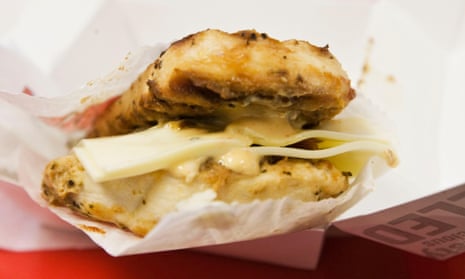A noteworthy poultry restaurant founded more than 80 years ago in the heart of Appalachia is reinventing the French classic chicken cordon bleu.
The decadent dish – revised for the modern American palette – features smoked, cured pork belly bursting with umami and topped with two semi-hard Californian cheeses. Sweet peppers, rosemary, habanero chiles, garlic and jalapeño provide piquant notes, as does a signature sauce crafted by an exclusive artisan butcher. The blend is then wrapped between two succulent white-meat chicken fillets, breaded with light seasonings and pressure-fried to perfection.
The cost of this indulgence? $4.99, at your local KFC.
The Double Down returned Monday after a four-year hiatus, during which its cult following – 30,000 fans on Facebook alone – could only obtain it as a secret, off-menu item. Food critics are horrified by the sandwich's very existence. For instance, the New York Times' Sam Sifton referred to it as "a disgusting meal, a must-to-avoid." The Village Voice's Robert Sietsema boasted disparagingly that he "ate it, and lived!" Fried chicken hasn't caused this much controversy since Chick-Fil-A’s public opposition to marriage equality.
Stunt foods have been around since time immemorial, but what makes the Double Down so different from the heralded cronut? Aside from the obvious sweet-versus-savory divide, it's all about the marketing and prestige: both items are five-dollar fried fads constructed from commonplace cholesterol-bomb ingredients. The KFC Double Down has 540 calories and 32 grams of fat; the cronut has 590 calories and 35 grams of fat.
There's an undercurrent in the many critiques of the fast food industry's latest wave of wacky concoctions implying that those who willingly partake are as revolting as the foods themselves. Fast food is inextricably linked with low-income Americans, with supposedly unrefined palates and a dearth of knowledge about what's "good" for them, while similarly convoluted, caloric treats at higher price points in finer establishments inspire block-long lines and thoughtful reviews. Regardless of one's tastes, the classism is palpable.
Foodies may rationalize their outrage against the Double Down by claiming that they're worried about consumer health, but how many of them are truly upset by millions of Americans' lack of geographic and economic access to healthy foods? You can't throw a stone without hitting a gourmand horrified by McDonalds' pink slime or reconstituted nuggets, but more than a few will shell out for a foie gras-topped burger despite efforts by animal activists to ban the product all together.
If "stunt foods" are attention-trolling, then pseudo-activist criticism is merely concern-trolling.
There's nothing wrong with enjoying the cheap thrill of forbidden food, but railing against it is as tiresome and sanctimonious as bragging about not owning a TV. The backlash against culinary self-righteousness is what led to the past decade's equally exhausting non-stop celebration of bacon – a bandwagon that ironically ended up bringing plenty of foodies on board.
It all comes full circle: With the development of bacon chocolate, bacon mayo and even bacon vodka, it's clear stunt foods are not only about publicity, but absurdity – but it's the price point and the size of the intended consumer's bank account that separates the indulgent from the dangerous.
